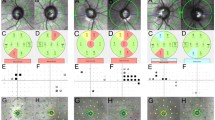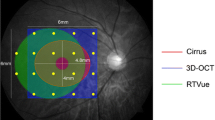Abstract
Background
This study compared SLO microperimetry scotoma size measurements with the sizes of lesions assessed with OCT in the areas of scotoma.
Methods
SLO microperimetry was performed on eight patients to assess the location and extent of scotoma areas. An SLO microperimetry master image was used to localize the scotoma areas in the real time OCT fundus image and to center OCT cross scans on the areas of scotoma. The sizes of the morphological changes measured by OCT were compared with the scotoma size measurements.
Results
In each patient, OCT revealed a morphological change located in the area of scotoma. Scotoma sizes ranged from 465 to 3180 μm horizontally and from 570 to 2550 μm vertically. The corresponding lesion sizes ranged from 461 to 2660 μm horizontally and from 523 to 2282 μm vertically. The average difference between SLO and OCT measurements was 2.4% horizontally and 4.9% vertically. There were significant correlations between horizontal and vertical SLO and OCT measurements (Horizontal: R sq=0.955, P<0.0001; Vertical: R sq=0.898, P=0.0003).
Conclusion
SLO microperimetry scotoma size measurements and OCT lesion size measurements are similar to each other. Combining retinal functional testing with morphological testing provides information about the underlying causes of scotoma.



Similar content being viewed by others
References
Altaweel M, Ip M (2003) Macular hole: improved understanding of pathogenesis, staging, and management based on optical coherence tomography. Semin Ophthalmol 18:58–66
Gallemore RP, Jumper JM, McCuen BW II, Jaffe GJ, Postel EA, Toth CA (2000) Diagnosis of vitreoretinal adhesions in macular disease with optical coherence tomography. Retina 20:115–120
Goebel W, Kretzchmar-Gross T (2002) Retinal thickness in diabetic retinopathy: a study using optical coherence tomography (OCT). Retina 22:759–767
Hagimura N, Iida T, Suto K, Kishi S (2002) Persistent foveal retinal detachment after successful rhegmatogenous retinal detachment surgery. Am J Ophthalmol 133:516–520
Hee MR, Izatt JA, Swanson EA, Huang D, Schuman JS, Lin CP, Puliafito CA, Fujimoto JG (1995) Optical coherence tomography of the human retina. Arch Ophthalmol 113:325–332
Jalkh AE, Avila MP, Trempe CL, Schepens CL (1983) Management of choroidal neovascularisation within the foveal avascular zone in senile macular degeneration. Am J Ophthalmol 95:818–825
Jamara RJ, Van De Velde F, Peli E (2003) Scanning eye movements in homonymous hemianopia documented by scanning laser ophthalmoscope retinal perimetry. Optom Vis Sci 80:495–504
Mori K, Gehlbach PL, Sano A, Deguchi T, Yoneya S (2004) Comparison of epiretinal membranes of differing pathogenesis using optical coherence tomography. Retina 24:57–62
Nichols PF (1988) Evaluation of choroidal neovascular membranes by octopus perimetry. Retina 8:24–29
Podoleanu AG, Dobre GM, Cucu RG, Rosen R, Garcia P, Nieto J, Will D, Gentile R, Muldoon T, Walsh J, Yannuzzi LA, Fisher Y, Orlock D, Weitz R, Rogers JA, Dunne S, Boxer A (2004) Combined multiplanar optical coherence tomography and confocal scanning ophthalmoscopy. J Biomed Opt 9:86–93
Pomerantzeff O, Webb RH (1980) Scanning ophthalmoscope for examining the fundus of the eye. US patent 4, 213, 678
Puliafito CA, Hee MR, Lin CP, Reichel E, Schuman JS, Duker JS, Izatt JA, Swanson EA, Fujimoto JG (1995) Imaging of macular diseases with optical coherence tomography. Ophthalmology 102:217–229
Strom C, Sander B, Larsen N, Larsen M, Lund-Andersen H (2002) Diabetic macular edema assessed with optical coherence tomography and stereo fundus photography. Investig Ophthalmol Vis Sci 43:241–245
Van Kerckhoven W, Lafaut B, Follens I, De Laey JJ (2001) Features of age-related macular degeneration on optical coherence tomography. Bull Soc Belg Ophthalmol 281:75–84
Webb RH, Hughes GW (1981) Scanning laser ophthalmoscope. IEEE Trans Biomed Eng BME 28:488–492
Yamamoto S, Yamamoto T, Hayashi M, Takeuchi S (2001) Morphological and functional analyses of diabetic macular edema by optical coherence tomography and multifocal electroretinograms. Graefe Arch Clin Exp Ophthalmol 239:96–101
Author information
Authors and Affiliations
Corresponding author
Rights and permissions
About this article
Cite this article
Menke, M.N., Sato, E., Van De Velde, F.J. et al. Combined use of SLO microperimetry and OCT for retinal functional and structural testing. Graefe's Arch Clin Exp Ophthalmo 244, 634–638 (2006). https://doi.org/10.1007/s00417-005-0088-2
Received:
Revised:
Accepted:
Published:
Issue Date:
DOI: https://doi.org/10.1007/s00417-005-0088-2




